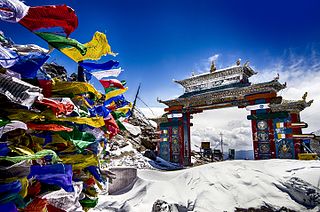Dravidian, Dravidan, or Dravida may refer to:
Naga or NAGA may refer to:

Manipur is a state in northeast India, with the city of Imphal as its capital. It is bounded by the Indian states of Nagaland to the north, Mizoram to the south and Assam to the west. It also borders two regions of Myanmar, Sagaing Region to the east and Chin State to the south. The state covers an area of 22,327 km2 (8,621 sq mi). The official and most widely spoken language is the Meitei language. Native to the Meitei people, it is also used as a lingua franca by smaller communities, who speak a variety of other Tibeto-Burman languages. Manipur has been at the crossroads of Asian economic and cultural exchange for more than 2,500 years. This exchange connects the Indian subcontinent and Central Asia to Southeast Asia, East Asia, Siberia, regions in the Arctic, Micronesia and Polynesia enabling migration of people, cultures and religions.

Imphal is the capital city of the Indian state of Manipur. It is the third largest city in northeast India after Guwahati and Agartala. The metropolitan centre of the city contains the ruins of Kangla Palace, the royal seat of the former Kingdom of Manipur, surrounded by a moat. Spread over parts of the districts of Imphal West and Imphal East, the former contains the majority of the city's area and population. Imphal is part of the Smart Cities Mission under the Ministry of Housing and Urban Affairs. Being a mega commercial hub, Imphal is known for its weaving, brass-ware, bronze-ware, and other cottage industries. Meitei language is the most widely spoken language in the city.

Northeast India, officially the North Eastern Region (NER), is the easternmost region of India representing both a geographic and political administrative division of the country. It comprises eight states—Arunachal Pradesh, Assam, Manipur, Meghalaya, Mizoram, Nagaland and Tripura, and the "brother" state of Sikkim.

The Meitei people, Meetei, Manipuri people is an ethnic group native to Manipur. They form the largest and dominant ethnic group of Manipur in Northeast India. They speak the Meitei language, one of the 22 official languages of the Republic of India and the sole official language of Government of Manipur. The Meiteis primarily settled in the Imphal Valley region in modern-day Manipur, though a sizeable population has settled in the other Indian states of Assam, Tripura, Nagaland, Meghalaya, and Mizoram. There is also a notable presence of Meitei people in the neighbouring countries of Myanmar and Bangladesh. The Meitei ethnic group represents about 53% of Manipur's population.
Maku, Magu or Makku may refer to:

The Insurgency in Northeast India involves multiple separatist militant groups operating in some of India's northeastern states, which are connected to the rest of India by the Siliguri Corridor, a strip of land as narrow as 14.29 miles (23.00 km) wide.
Bishnupur or Vishnupur may refer to:

Shantidas Adhikari, also known as Shantidas Gosai or Shantidas Goswami, was a Hindu preacher from Sylhet, Bengal, who converted King Pamheiba of Manipur from Sanamahism, the traditional Meitei religion, to Vaishnavism in 1717 CE.
Moreh is a border town located on the India–Myanmar border in Tengnoupal district of the Indian state of Manipur. As a rapidly developing international trade point with the integrated customs and international immigration checkpoint, Moreh plays an important role in India's Look East Policy, trade and commerce under ASEAN–India Free Trade Area, India-Myanmar relationship, India–Myanmar–Thailand road connectivity, and Trans-Asian Railway connectivity.
Manipuri people aka Meitei people are the predominant ethnic group of Manipur in Northeast India.

The Manipur Kingdom also known as Meckley was an ancient kingdom at the India–Burma frontier. Historically, Manipur was an independent kingdom ruled by a Meitei dynasty. But it was also invaded and ruled over by Burmese kingdom at various point of time. It became a protectorate of the British East India Company from 1824, and a princely state of British Raj in 1891. It bordered Assam Province in the west and British Burma in the east, and in the 20th century covered an area of 22,327 square kilometres and contained 467 villages. The capital of the state was Imphal.
Rajkumar Jhalajit Singh was an Indian writer, historian, Gandhian and academic. He was known for his book, "A Short History of Manipur", which was banned from publishing or selling by his own family members, because the book misleads the readers that the Manipuris are the descendants of Arjuna of the Mahabharata.
Neelamani Devi is an Indian craftswoman and master potter from Manipur. Her creations have been the theme of two documentary films; Mittee aur Manab by renowned filmmaker, Mani Kaul, and Nilamani: The Master Potter of Manipur, by Aribam Syam Sharma. The TV Series, Mahabharata also featured her works on one of the episodes. The Government of India awarded her the fourth highest civilian honour of the Padma Shri, in 2007, for her contributions to the art of pottery making.
Manipura, also known as Manalura, is a kingdom mentioned in the Hindu epic Mahabharata. According to the epic, it was located near a sea-shore, the Mahendra Mountains and the Kalinga Kingdom. Arjuna—one of the five Pandava brothers—visited Manipura and married Chitrangada, the princess of the kingdom. They had a son named Babruvahana who later ruled it.
Ancient Manipur may refer to:
Manipuri mythology is the mythology of the Meitei people, the predominant ethnic group in Manipur, India.






